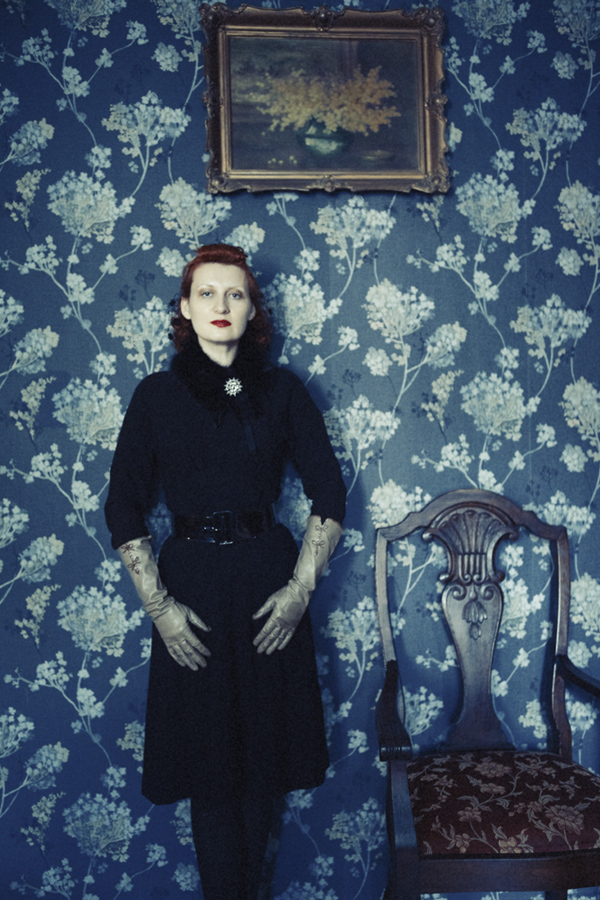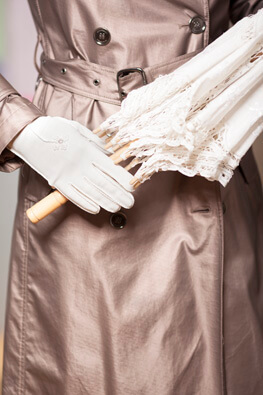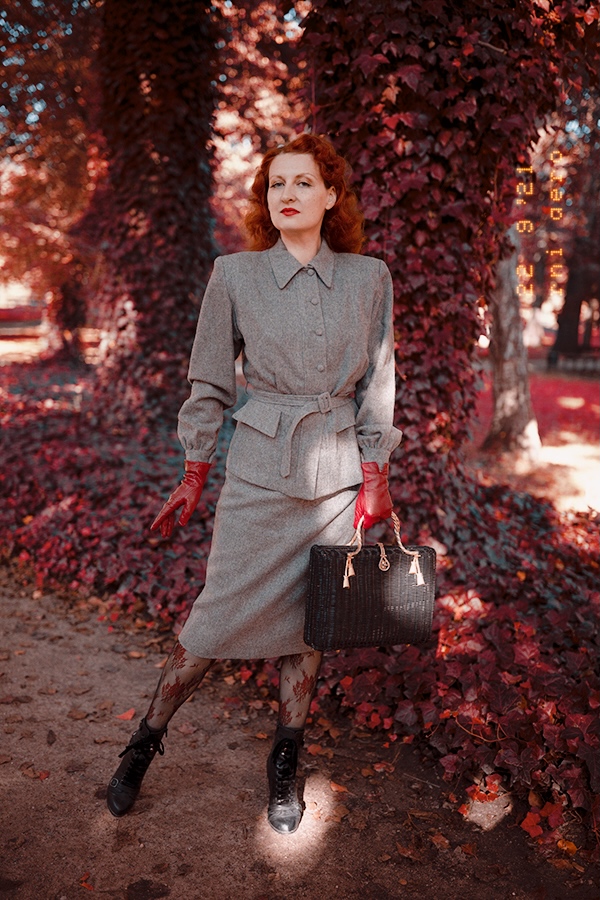The Vintage Glove Etiquette

Last updated on July 4th, 2024 at 10:50 am
- Vintage Gloves For All Seasons
- The Not-So-Secret Glove Language
- Glove Etiquette in the 20th Century
- How to Pair Vintage Gloves with Your Outfit
- The Vintage Glove Etiquette for Eating and Drinking
- Don’t be Afraid of Vintage Gloves in Different Colours
- How to Wash Vintage Gloves
A woman without gloves is a marked woman. It’s like going barefoot to be without them. Gloves are traditionally a sign of dignity.
Claire McCardell

THE VINTAGE GLOVE ETIQUETTE
For my vintage winter look, I opted for a pair of long 1940s gloves, a purple hat from the late 1930s and a faux fur cape from Helen Moore.
I love nothing more than the feeling of soft leather or suede caressing my skin as I put on my first pair of gloves for the winter season. It’s a sensation that brings with it, its very own special pleasure. Mother Nature can be particularly cruel where I live at this time of year, but she at least brings with her this gift of bliss in disguise, hidden as a private moment shared between one woman and another.
She wasn’t the first to introduce me to the pleasure of gloves though. That claim belongs to Rita Hayworth or more accurately, her character Gilda, in the film of the same name, whose performance inspired me to purchase my first pair of long, satin opera gloves that I’ve cherished for over 20 years.
And even though my collection has expanded to now include vintage gloves of different colours, lengths and materials be it silk, suede, cotton or lace. I don’t think, that my thirst for shopping gloves will ever be fully satisfied! And why should it?
Rita Hayworth in “Gilda”
The vintage glove etiquette.

Vintage Gloves For All Seasons
Wearing gloves doesn’t have to be just about protection from the weather and I’ve always fancied the idea of wearing gloves (particularly vintage ones) for all occasions and all year round, just like the exquisitely dressed ladies of the 19th century who had clever ulterior motive going on behind the wearing of heir gloves.
If I was a woman, I would be dressed in the same thing for a month and just change my hat and gloves. Maybe my shoes too; yes, I see what you mean but, really, it’s jewels that change an outfit.
Manolo Blahnik
Vintage gloves in winter:
I paired the 1950s leather gloves with a 1940s skirt, couture top and faux fur from Helen Moore.

Vintage gloves in the spring:
The same 1950s leather gloves I so often wear in winter are also perfect for cooler spring days.

Vintage gloves in the summer:
I love the 1950s sheer wrist-length chiffon gloves with fine black pinstripes as they compliment all my 1940s skirt suits rather well.

DISCLOSURE: As of October 2021, I’m part of an affiliate program, and I get a small commission for purchases made through the Shop My Style links in this post. That’s how I keep my website alive, for which I’m very grateful to you. All opinions expressed here are mine!
SHOP MY STYLE
The Not-So-Secret Glove Language
In the 1800s gloves played a very significant role in affairs of the heart, as because of the strict rules of conduct, it was difficult for a lady to communicate her desires.
Propriety was the byword and a young lady’s reputation could have been easily ruined, so to avoid any unpleasant situations many books were published explaining the meaning of specific signals to help a lady show her true feelings and not to be caught by doing so. After all, she would be using a secret code (not so secret to those who have read the books) without having to be in direct contact with the suitor.
- Dropping one of the gloves meant- yes.
- Dropping both gloves – I love you.
- Using gloves as a fan – Introduce me to your company.
- Turning them inside out – I hate you.
- Folding a glove – get rid of your company.
- Tossing gloves to the side – I am engaged.
- Pressing the end of the tip of the glove to lips – do you love me?
- Holding them hanging loose in my right hand – I’m satisfied.
- Tapping the chin with gloves meant – I love another.
And while we’re still in the 1800s, here’s a rough guide to get you through formal glove etiquette
- Gloves were always put on at home and never in public.
- They were to be removed during supper or playing cards. Discretion was required and gloves had to be removed under the table and placed on the lap, which was covered by a serviette.
- They were also removed during the application or touch-up of make-up.
- But gloves were never to be removed when shaking hands on the street.
And her old Uncle William used to say a lady is known by her shoes and her gloves.
― Virginia Woolf, Mrs Dalloway
Glove Etiquette in the 20th Century
Different styles of gloves have been available in the past, each with its unique charm and versatility. From classic wrist-length gloves to dramatic above-elbow-length ones, gloves have been an essential part of fashion for decades. They add a touch of elegance and sophistication to any ensemble, vintage or modern, and are perfect for both daytime and evening wear.
Popular glove styles:
- Wrist-length gloves
- Coat-length gloves
- Elbow-length gloves
- Opera gloves
- Gauntlet gloves
- Mousquetaire gloves

Wrist-length gloves are the shortest style of gloves. They hit at or slightly above the wrist bone and are very versatile. You can wear them with practically any vintage or contemporary outfit.

The elegance and versatility of classic coat-length gloves are truly inspiring. These gloves gracefully hitting the mid-way point or slightly above it on the forearm, are a timeless style. The ruching detail, similar to the gloves in the photograph above, allowing the gloves to be adjusted to perfectly match the length of the wearer’s sleeves, adds to the elegance of the entire ensemble.

My favourite elbow-length gloves ( alright, I say that about all gloves) are a type of glove that extends to, or just below, the elbow. These gloves were predominantly worn during the mid-twentieth century and were considered the most striking glove length for daytime wear. They were also a popular choice for evening wear, especially in situations where longer opera-length gloves would have been too formal or inconvenient.

Evening or opera gloves are a type of glove that is typically worn for formal occasions. These gloves are longer than regular gloves and are designed to extend above the elbow, sometimes even reaching up to the underarms. These gloves were often adorned with small buttons ( a bit of a nightmare if you ask me) that could be fastened by hand or with the aid of special knitting needle-like hooks. Opera gloves are certainly the most dramatic and spectacular style but trust me when I say that they are not very convenient in particular when you need to use the powder room.

Gauntlet gloves are characterized by a turn-up or cuff, which often points outward and often comes partway up the forearm. However, they could be wrist length as well. This popular style remains a dramatic and beautiful way to add a stylish dose of mid-century allure to any ensemble. It’s also the most expensive style among vintage gloves. Sigh.

How to Pair Vintage Gloves with Your Outfit
To quote from an ad for Van Raalte gloves in the 1950s.

The shorter your sleeves, the longer your gloves. This year-of all years-you’ll have a crush on these loves of gloves by Van Raalte. For they rise to every occasion-every costume-from the push-up sleeves of your new spring coat to the no-sleeves-at-all of so many summer dresses. And they’re made of Amersuede,* Van Raalte famous double-woven rayon that looks and feels like seuede, wears and washes like a dream, takes to colors beautifully..The longest glove, $4.00.
In general, you can choose whichever length of gloves you prefer when wearing dresses with short sleeves. However, it is crucial to coordinate them with your outfit’s colour, fabric, and time of year. For instance, during autumn and winter, I match dresses made of thicker material with elbow or short-length leather gloves. On the other hand, in the summer, I wear the more weather-appropriate, short sheer gloves, typically crafted from nylon or lace. The high temperature and humidity in Poland during summer are unbearable and I couldn’t wear gloves made of anything other than cotton, thin rayon or nylon.
Suede is my second favourite fabric for vintage gloves right after leather, which is why I have them in abundance. All of my vintage opera gloves are in suede rather than silk.
I also love ruched gloves in bright colours because they are a match made in heaven with my 1940s and 1950s skirt suits.
The Vintage Glove Etiquette for Eating and Drinking
Modern living doesn’t make eight-button, twelve-button rules-common sense and Fashion acknoledge this. Longer than short will take you through most formal ocassions. But when to take gloves off may pose a few problems. When you go to a cocktail party, even if your satin or velvt gloves are an inegral part of your costume, don’t touch the hors d’oeuvre tray until you have removed your gloves.
Claire McCardell, ‘What Shall I Wear’, 1956
No. Remove your gloves discreetly once you are seated at the table. Fold them and keep them on your lap.
You can drink with your gloves on, especially if you are wearing opera gloves.
Leave your evening gloves on when shaking hands.
To quote Claire McCardell, ‘Never wear jewelry outside of gloves.’ I, however, find it acceptable, although unnecessary to wear a bracelet over evening gloves.
FABULOUS VINTAGE GLOVES
Don’t be Afraid of Vintage Gloves in Different Colours

Vintage gloves are not the only type I obsessively buy, I have a fast-growing collection of modern leather gloves in many colours, lengths and patterns. In the past, I wouldn’t even consider any other colour than black but I’ve converted after trying a pair in the perfect shade of red and then the perfect shade of blue, yellow, you see where I’m going with this.
I will not rest until I have a pair of leather gloves in the perfect shade of every colour known to a woman. I present to you all my on-growing collection of one of the most important fashion accessories of all time!










The Vintage Glove Etiquette
The new to me 1940s Koret of California skirt suit paired with contemporary red leather gloves.

How to Wash Vintage Gloves
I found an ad for Ivory Snow Soap from 1934 with instructions on how to wash gloves. And I always spot clean vintage leather gloves and would NEVER risk submerging them in water.
Also, I use Eucalan which doesn’t require rinse or saddle soap for spot cleaning.
You should be VERY cautious when cleaning vintage leather.
A friend of mine, one of the biggest vintage Haute Couture collectors in Europe, sent a pair of 1950s Dior leather gloves to the dry cleaner and… There was not much left of them
Do it at your own risk!

- Use Ivory Snow and just barely lukewarm water. Hot water is fatal to gloves. Ivory Snow melts instantly in water that is safely cool
- Wash gloves INSIDE and well as OUTSIDE. A soft nail brush helps to get finger-ends clean.
- Rinse thoroughly inside and out in barely LUKEWARM water. No flat particles in Ivory Snow to cling flat to the leather and make rinsing difficult-no soap spots!
- DON’T SQUEEZE or wring gloves. Lay them flat between folds of Turkish towel and pat loose water out
- Don’t hang wash-leather gloves to dry on a hot radiator or overheat of any kind.
- Soften by working onto your hands just BEFORE they are dry.
Are you as fond of gloves as I am?


